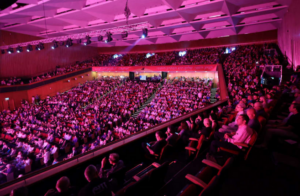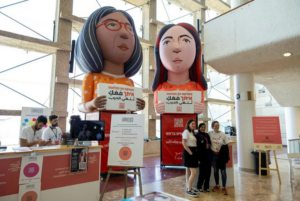‘The abyss is deep,’ but the People’s Peace Summit proved Israel has a peace camp

People’s Peace Summit in Jerusalem, May 2025
Rachel Fink and Linda Dayan report in Haaretz on 11 May 2025:
There is perhaps no more fitting place to kick off a Jerusalem Peace Summit than at the least–peaceful summit in all of Jerusalem – the Temple Mount/Haram al–Sharif compound. Holy to both Jews and Muslims, Israelis and Palestinians, the contested plateau sits atop the fault line of two national claims, and lies at the center of decades of bloodshed, surveillance, and struggles over authority and access.
On Thursday morning, it was also an important stop on the five-hour walking tour around the Old City called “Two Guides, Two Narratives,” one of a slew of Jerusalem–based activities offered to participants on the first day of the two–day People’s Peace Summit, held under the auspices of It’s Time – a coalition of dozens of Palestinian and Israeli peacebuilding and shared society organizations.
The concept of the tour is simple, though the execution is anything but: two guides – one Israeli, one Palestinian – walk side by side through the Old City, each presenting their personal, sometimes contradictory, framing of ancient alleyways and sacred sites. It is the brainchild of Aziz Abu Sarah, a journalist and co-founder of Mejdi Tours, who also happens to be serving as the Palestinian guide, alongside Yael Moav, a Jewish Israeli. When she’s not guiding, Moav devotes much of her time and energy to activism.
Like the peace movement itself, the experience offers no illusion of complete consensus. The dialogue is purposely left unscripted to allow for meaningful discussion and moments of unexpected resonance. Or conflict.
At one point, Moav makes a passing comment about October 7, and she is surprised to find herself on the defensive – not from Abu Sarah or the two Palestinian participants, but from fellow left-wing Israelis. As the exchange grows heated, it is a pointed reminder of one of the many challenges facing this newly revitalized peace camp: building a broad-based coalition, even among those with shared goals, is no simple task.
A Crowd of the Committed
After a full day of films, concerts, art installations, and multi-faith prayer services hosted by It’s Time coalition partners across the city, the People’s Peace Summit officially kicked off Friday morning at Jerusalem’s International Convention Center. By 9:00 a.m., a long line had formed: twenty-something activists in matching shirts, families with young children, and a steady stream of silver-haired pensioners filed through security.
Inside, the hall buzzed with energy: Druze-style pitas, iced coffee, and bourekas were on offer, while organizations handed out flyers and tote bags. In one corner, a group of women sat knitting beneath a sign that read “Women Weave Life.”

The People’s Peace Summit this weekend. Organizations handed out flyers and tote bags
The crowd skewed heavily toward Hebrew speakers, though not exclusively. On the steps outside the auditorium, Ikhlas and her husband Mahmoud snapped a selfie with homemade signs reading “No to War, Yes to Peace” in Arabic and Hebrew. They had driven four hours from the northern town of Nujaydat earlier that morning. “It was very difficult,” Ikhlas admitted, “but we do what we can. It’s worth it.”
Nodding, Mahmoud said: “We came to bolster the peace movement, because it’s very important to us that they end the war. Enough. What’s happening there is disgusting.”
“Bigger, Wider, Deeper”
As the auditorium filled to its 3,000-seat capacity, actor Yossi Marshak and journalist Nadin Abou Laban welcomed the crowd, declaring that Israel’s peace camp is “bigger, wider, deeper, and more diverse” than ever before. A procession of speakers followed – artists, academics, reservists, bereaved parents, relatives of hostages still held by Hamas, and anti-government activists – each representing a different group disillusioned with the current path and united in calling for an immediate cease-fire, the return of all hostages, an end to the occupation and the creation of a shared political future.
They were followed by three Israeli-Palestinian pairs working toward those goals: Rula Daood and Alon-Lee Green of Standing Together; Maoz Inon, whose parents were murdered by Hamas on October 7, and his partner, Aziz Abu Sara, the Palestinian guide from Thursday’s tour, whose brother died in Israeli custody; and Dr. Yael Admi and Sumaya Bashir of Women Wage Peace. “This is the time for women – all women – to stand tall,” Bashir declared. “To work together hand in hand, in deep partnership for a future of equality, freedom, security, and peace for everyone.”
Behind them, a photo of slain co-founder Vivian Silver – murdered in her home at Kibbutz Be’eri by Hamas on October 7 – appeared on screen, with the words “Following in your footsteps” in Hebrew, Arabic and English. Admi named two more women the group has lost: Nadia, the Gaza coordinator killed in an airstrike, and Suzan Abdelqader Bishara, shot in Tira last April. Wiping away tears, she also mentioned her brother Yishai, killed in what she called “yet another pointless war that could have been prevented.”
From Macron to Tibi
The event also featured an impressive roster of political figures, including recorded messages from French President Emmanuel Macron, Palestinian Authority President Mahmoud Abbas, and MK Yair Golan of the Democrats party, who pledged to include an Arab party in any future coalition.
Golan is a leading voice against Israel’s far-right government and the settler movement, but hasn’t aligned himself with the peace camp since October 7, taking a more hawkish, security focused stance. Within the camp, he has faced criticism for not speaking out clearly against the occupation and the devastation of the war across the border. He didn’t directly address those things in his message either. He did use the word peace, saying it shouldn’t be a “dirty word.”
Frequent It’s Time participants MK Gilad Kariv and MK Naama Lazimi, also of the Democrats, spoke in person, as did Ta’al party MK Ahmad Tibi. Tibi, who said he has lost a double-digit number of relatives in Gaza, delivered one of the morning’s most searing speeches. “Palestinian society is undergoing a continuous massacre,” he said. “Months of relentless bombings, day after day, night after night. Every hour, a child is killed in Gaza. Tens of thousands of civilians – women, children, and the elderly – have died from bombings and starvation.”
“These are war crimes,” he charged. “We must not ignore them. We must not forget that there is an occupation here, just as we must not forget the siege.” Despite the gravity of his words, Tibi closed on a hopeful note, vowing to unify the Arab parties and boost voter turnout in the next elections. He ended with a quote from Turkish poet Nâzım Hikmet: “The most beautiful days are those we have yet to live.”
As the third major event in the It’s Time coalition’s repertoire, this year’s summit combined the scale of last summer’s Great Peace Conference in Tel Aviv with the diversity and intimacy of December’s weeklong “People’s Peace Journey” across the country. After the opening ceremony, participants chose from dozens of smaller sessions – a program that “speaks to the head and to the heart and to the gut,” as content director Mika Almog put it.
The format was not without hiccups: technical glitches, scheduling delays and travel disruptions, some circumstantial, others systemic. While several international speakers were grounded by flight cancellations due to last week’s Houthi rocket attack, many Palestinians, both speakers and attendees, were denied permits to enter Israel, a stark reminder that even the most inclusive peace conference remains shaped by an asymmetrical reality on the ground.

Women at the People’s Peace Summit
Diplomacy, Reconciliation and a Dance Party
Still, organizers clearly took past critiques to heart – specifically the claim that the movement lacked serious policy plans – and responded with a packed agenda of high-level panels, strategy workshops, and forward-looking debates. There were still plenty of feel-good activities, the kind critics like to dismiss as “not going to solve the conflict” – like arts and crafts, raucous dance parties, and a meditation tent – but these were balanced by two full blocks of sessions tackling weightier topics: diplomacy, security, borders, transitional justice, and reconciliation.
In the main hall, Dr. Roee Kibrik of Mitvim, which describes itself as “a pro-peace Israeli foreign policy think tank,” interviewed Palestinian journalist Mohammed Daraghmeh about shifting regional dynamics. Daraghmeh argued that the U.S. is now pursuing regional arrangements independently of Israel’s priorities, pointing to Trump’s outreach to the Houthis and Iran and an upcoming visit to the region that bypasses Israel. He called this a significant shift that could benefit the peace camp, but warned that expanding settlements are “killing the two-state solution,” and urged international sanctions “before the window closes.”
Later, former Israeli Prime Minister Ehud Olmert and former Palestinian Foreign Minister Nasser Al-Kidwa presented their two-state framework. “The bloodletting is frankly too much to bear,” said Al-Kidwa via satellite. “We need a government structure organically linked to the Palestinian Authority, a release of all hostages and prisoners, and a credible Arab security presence to stabilize the situation.” Olmert agreed: “Gaza is Palestinian. It’s not Israel, and it must be part of the Palestinian state.”
Next door, a panel organized by the Alliance for Middle East Peace (ALLMEP) brought together senior diplomats to discuss the international community’s role in advancing peace. The session opened with a recorded message from European Commission Vice-President Kaja Kallas, reiterating the pledge to an additional 18 million euros in EU funding for Israeli and Palestinian civil society organizations. “Civil society must also have the space to operate,” she said to loud applause. “Legislation should never be used as a tool to reduce this space.”
Afterward, ambassadors from France, Germany, the Netherlands, and the EU’s representative to the Palestinian Territories discussed the contours of a future two-state solution and the regional benefits of Israeli-Saudi normalization.
A louder, sharper summit
While this year’s summit echoed the familiar refrain from last July – that Israelis and Palestinians are both here to stay and must find a way to live together – the tone had clearly shifted. This time, there was more urgency, more frustration. Some speakers shouted into microphones, demanding an end to the bloodshed.
And unlike last year’s event, which evenly spotlighted Israeli and Palestinian victims, this summit did not shy away from the vastly higher Palestinian death toll, though it also acknowledged the 59 hostages still in captivity in Gaza. Many speakers didn’t hold back in their language, condemning “ethnic cleansing,” deliberate starvation in Gaza, and brutal settler violence in the West Bank.
“There are tens of thousands more victims than there were last year,” Maoz Inon told Haaretz as the conference was in full swing. “The abyss is deeper and reality is bloodier. To have a peace and reconciliation event is even more difficult, and demands even more courage and determination.”
Still, ever the optimist, Inon finds hope in the growing momentum. The Israeli social entrepreneur and longtime activist noted that the coalition has grown, with more organizations joining since last year and attendance surpassing 5,000. “And,” he added, “we’re not in our comfort zone of Tel Aviv. I think we’re more determined, we have a much more built-up strategy, and we’ll implement it. And now we have a goal, too. Peace by 2030.”
This article is reproduced in its entirety
